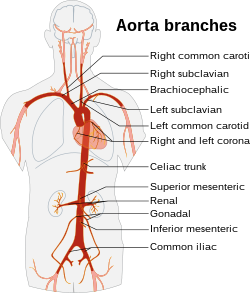
Back أبهر (شريان) Arabic Aorta AST Aorta Azerbaijani Аорта Byelorussian Аорта Bulgarian মহাধমনী Bengali/Bangla Aorta BS Aorta Catalan ЦӀиймарш CE شاخوێنبەر CKB
| Aorta | |
|---|---|
 Schematic view of the aorta and its segments | |
 Branches of the aorta | |
| Details | |
| Pronunciation | /eɪˈɔːrtə/ |
| Precursor | Truncus arteriosus, fourth left branchial artery, paired dorsal aortae (combine into the single descending aorta) |
| Source | Left ventricle |
| Branches | Ascending aorta:
Arch of aorta (supra-aortic vessels): Descending aorta, thoracic part:
Descending aorta, abdominal part:
Terminal branches: |
| Vein | Combination of coronary sinus, superior vena cava and inferior vena cava |
| Supplies | The systemic circulation (entire body with exception of the respiratory zone of the lung which is supplied by the pulmonary circulation) |
| Identifiers | |
| Latin | aorta, arteria maxima |
| MeSH | D001011 |
| TA98 | A12.2.02.001 |
| TA2 | 4175 |
| FMA | 3734 |
| Anatomical terminology | |
The aorta (/eɪˈɔːrtə/ ay-OR-tə; pl.: aortas or aortae) is the main and largest artery in the human body, originating from the left ventricle of the heart, branching upwards immediately after, and extending down to the abdomen, where it splits at the aortic bifurcation into two smaller arteries (the common iliac arteries). The aorta distributes oxygenated blood to all parts of the body through the systemic circulation.[1]
- ^ Maton, Anthea; Jean Hopkins; Charles William McLaughlin; Susan Johnson; Maryanna Quon Warner; David LaHart; Jill D. Wright (1995). Human Biology Health. Englewood Cliffs, New Jersey: Prentice Hall. ISBN 978-0-13-981176-0.